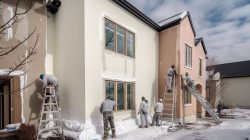Decoding Your Building’s Exterior: When to Ditch the Repairs and Opt for a Full EIFS Makeover
Introduction
Hey there, folks! If you’re reading this, chances are you’ve got some concerns about your building’s exterior insulation and finish system (EIFS). It’s a fantastic cladding option, offering energy efficiency and a sleek look, but like anything else, it’s not immortal. So, how do you know when it’s time to replace your EIFS instead of just repairing it? Buckle up, because we’re about to dive into the nitty-gritty of the top 7 signs that’ll help you make that call.
1. Cracking Up: When Small Fixes Won’t Cut It Anymore
We’ve all heard the saying, “Don’t put a band-aid on a broken leg.” Well, the same principle applies to your EIFS. Small cracks and superficial damage can usually be repaired, but when you start noticing:
- Widespread cracking
- Deep or structural cracks
- Repeated repairs in the same area
It might be time to consider replacing your EIFS instead of patching it up. These issues often indicate deeper problems that a simple repair won’t fix.
2. Water, Water Everywhere: Persistent Moisture Issues
EIFS is designed to keep moisture out, but even the best-laid plans can go awry. If you’re constantly battling:
- Water infiltration behind the EIFS
- Mold or mildew growth
- Stains or discoloration from water damage
You’ve got yourself a one-way ticket to Replacementville. Persistent moisture issues can lead to rot, structural damage, and health risks, so it’s crucial to address them ASAP.
3. A Sinking Feeling: Insulation Performance Dips
One of the main perks of EIFS is its insulation prowess. But if you’re noticing:
- Higher energy bills
- Drafts or cold spots in your building
- A decrease in indoor temperature stability
These could be red flags that your EIFS insulation isn’t up to snuff anymore. In such cases, it’s often more cost-effective to replace the whole shebang rather than trying to salvage it.
4. The Times, They Are A-Changin’: Outdated EIFS Technology
EIFS has come a long way since its inception, and if your system is old as the hills, it might be time for an upgrade. Keep an eye out for:
- Lack of drainage system
- Outdated materials or installation techniques
- Incompatibility with modern energy efficiency standards
If any of these sound familiar, replacing your EIFS with a newer, more advanced system is probably the best move for you and your building.
5. Beauty Is Only Skin Deep: Aesthetics Gone Awry
We all want our buildings to look spiffy, but if your EIFS is starting to resemble something out of a horror movie, it’s probably time for a change. Watch for:
- Fading or peeling finish
- Chalking or efflorescence
- Uneven or patchy color
These issues can make your building look run down and unappealing, and they’re often signs of deeper problems that warrant a full EIFS replacement.
6. The Winds of Change: Building Movement and Settling
It’s a fact of life: buildings move and settle over time. If your EIFS is struggling to keep up with these changes, you might need to think about replacing it. Signs of building movement that can impact your EIFS include:
- Gaps or separations between panels
- Warping or buckling of the EIFS
- New cracks or damage caused by shifting
If you’re seeing these issues, it’s worth consulting with an EIFS professional to assess whether a full replacement is in order.
7. Weighing the Pros and Cons: Cost-Benefit Analysis
Finally, sometimes it just comes down to dollars and cents. If you find yourself:
- Constantly shelling out for repairs
- Facing skyrocketing maintenance costs
- Dealing with a system that’s reaching the end of its lifespan
You might want to bite the bullet and opt for a full EIFS replacement. In the long run, it can save you money and give you peace of mind knowing your building is protected with a fresh, up-to-date system.
Frequently Asked Questions
Q: How long does EIFS typically last?
A: EIFS can last anywhere from 20 to 50 years, depending on factors like installation quality, maintenance, and environmental conditions. Regular inspections and maintenance can help extend its lifespan.
Q: How do I know if my EIFS was installed correctly?
A: If you’re unsure about the quality of your EIFS installation, it’s a good idea to consult with a professional EIFS inspector or contractor. They can assess your system and advise you on any necessary repairs or replacements.
Q: Can I replace my EIFS myself?
A: While some handy folks might be tempted to tackle EIFS replacement as a DIY project, it’s generally best left to the pros. EIFS installation requires specialized knowledge, tools, and materials, and an improper installation can lead to a whole host of problems down the line.
Conclusion
So there you have it – the top 7 signs it’s time to replace your EIFS instead of repairing it. While it can be a tough call to make, keeping an eye out for these indicators can help you protect your investment and ensure your building stays safe, energy-efficient, and looking sharp. Remember, when in doubt, consult with an EIFS professional for guidance. Happy renovating!

